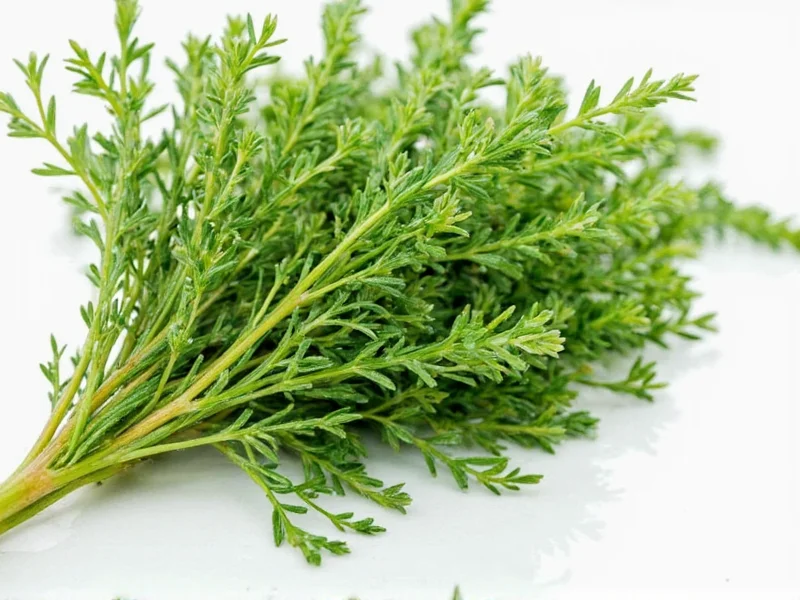Running out of thyme while cooking doesn't have to ruin your recipe. Understanding which herbs can effectively replace thyme's distinctive earthy, slightly minty flavor with subtle lemon notes is essential for maintaining your dish's intended taste profile. This guide provides practical, tested alternatives that work across various cooking applications.
Understanding Thyme's Unique Flavor Profile
Before selecting a substitute, it's important to recognize what makes thyme special. Fresh thyme offers a complex flavor—earthy with hints of mint, citrus, and floral notes—that enhances both delicate and robust dishes. When dried, thyme becomes more concentrated and slightly more medicinal in flavor. The best substitutes will match either the fresh or dried form you need to replace, depending on your recipe requirements.
Top 8 Thyme Substitutes Ranked by Effectiveness
Not all thyme alternatives work equally well in every situation. Here's how the most common substitutes compare for different cooking scenarios:
| Substitute | Substitution Ratio | Best For | Flavor Difference |
|---|---|---|---|
| Rosemary | 3/4 tsp dried rosemary = 1 tsp dried thyme | Roasted meats, potatoes, hearty stews | Stronger, more pine-like; use less to avoid overpowering |
| Oregano | 3/4 tsp dried oregano = 1 tsp dried thyme | Tomato-based dishes, Italian cuisine, grilled vegetables | More pungent, earthy; works well in Mediterranean recipes |
| Marjoram | 1:1 ratio (dried or fresh) | Egg dishes, light sauces, poultry, vegetables | Sweeter, milder; closest flavor match to thyme |
| Savory | 1:1 ratio (dried) | Bean dishes, stuffing, soups, grilled meats | Peppery with thyme-like notes; excellent 1:1 replacement |
| Herbes de Provence | 1:1 ratio | French cuisine, roasted vegetables, marinades | Contains thyme plus complementary herbs; ready-made blend |
| Basil | 3/4 tsp dried basil = 1 tsp dried thyme | Tomato sauces, pasta dishes, summer recipes | Sweeter, more floral; better for fresh applications |
| Tarragon | 1/2 tsp dried tarragon = 1 tsp dried thyme | Chicken, fish, egg dishes, creamy sauces | Distinct anise flavor; use sparingly as substitute |
| Sage | 2/3 tsp dried sage = 1 tsp dried thyme | Stuffing, pork dishes, winter recipes | Stronger, more camphor-like; best for robust dishes |
Best Thyme Substitutes by Dish Type
The ideal thyme replacement depends heavily on what you're cooking. Understanding which substitutes work best for specific applications ensures your dish maintains its intended flavor balance.
For Soups and Stews
When substituting thyme in liquid-based dishes like soups and stews, savory or marjoram provide the most similar flavor profile without overwhelming other ingredients. For French onion soup or beef stew, a small amount of rosemary (use only half the thyme quantity) adds depth without dominating. In tomato-based soups, oregano makes an excellent substitute at a 3:4 ratio.
For Poultry Dishes
Chicken and turkey benefit from marjoram as the top thyme alternative, using equal amounts whether fresh or dried. For roasted chicken, a blend of equal parts rosemary and oregano creates a complex flavor similar to thyme. When making chicken stock, a single bay leaf can surprisingly mimic thyme's earthy notes when combined with other standard aromatics.
For Vegetable Dishes
Roasted vegetables pair well with oregano as a thyme substitute, particularly root vegetables. For lighter vegetables like green beans or asparagus, tarragon works beautifully at half the thyme quantity. When making ratatouille or other Mediterranean vegetable dishes, herbes de Provence provides the most authentic flavor profile as a ready-made thyme alternative.
Dried vs. Fresh Herb Substitution Guidelines
Understanding the conversion between fresh and dried herbs is crucial when substituting for thyme. Dried herbs are more concentrated, typically requiring only one-third the amount of fresh herbs. When replacing fresh thyme:
- For every 1 tablespoon fresh thyme, use 1 teaspoon dried thyme
- When substituting other dried herbs for fresh thyme, use 1/2 to 2/3 the amount
- Fresh substitutes generally work at a 1:1 ratio with fresh thyme
Remember that dried herbs benefit from being added earlier in the cooking process to allow their flavors to fully develop, while fresh herbs are typically added toward the end of cooking.
Creating Your Own Custom Thyme Substitute Blend
For the most versatile thyme replacement, create a custom blend that mimics thyme's complex flavor profile. Combine these dried herbs in the following proportions:
- 2 parts marjoram (provides the sweet, floral notes)
- 1 part rosemary (adds earthiness)
- 1 part oregano (contributes depth)
- Pinch of lemon zest (optional, for citrus notes)
Store this blend in an airtight container for up to six months. Use at a 1:1 ratio when replacing dried thyme. This custom blend works particularly well as a thyme replacement for chicken dishes and tomato-based pasta sauces where you need a balanced herb profile.
When Substitution Might Not Work Well
While most recipes tolerate thyme substitutions, certain dishes rely heavily on thyme's unique flavor. Traditional bouillabaisse, herbes de Provence blends, and some French country recipes may lose their authentic character with substitutions. In these cases, consider making a quick trip to the store or adjusting your recipe rather than using a substitute that significantly alters the intended flavor profile.
Practical Tips for Successful Herb Substitution
Season in stages when using substitutes—add half the recommended amount initially, then taste and adjust. Stronger substitutes like rosemary and sage should always be used more sparingly than the thyme they replace. For delicate dishes like fish or egg preparations, milder substitutes like marjoram work best. When in doubt, combine two complementary herbs rather than using a single substitute to better approximate thyme's complex flavor.











 浙公网安备
33010002000092号
浙公网安备
33010002000092号 浙B2-20120091-4
浙B2-20120091-4